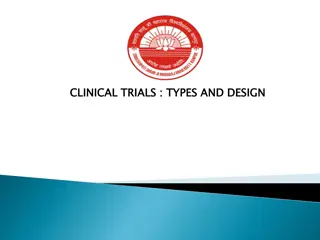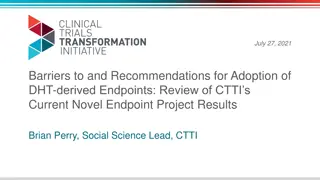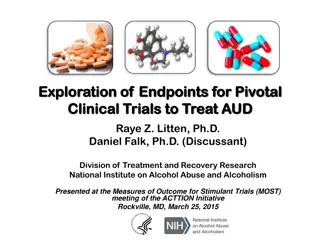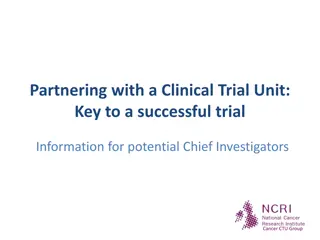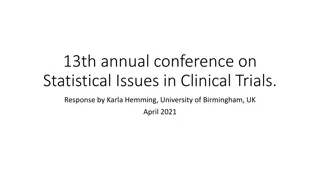Introduction to Experimental Studies in Clinical Trials
Clinical trials play a crucial role in advancing medical research by evaluating experimental treatments through various study designs. This introduction explores the definition of clinical trials, the importance of experimental studies, different types of experiments, principles of experimental design, and the role of treatments and experimental units in research. It emphasizes the significance of randomization and blinding in ensuring unbiased results and discusses common challenges faced in nutrition clinical trials. Practical applications and good clinical practices are also highlighted to improve the quality and reliability of research outcomes.
Uploaded on Mar 12, 2025 | 0 Views
Download Presentation

Please find below an Image/Link to download the presentation.
The content on the website is provided AS IS for your information and personal use only. It may not be sold, licensed, or shared on other websites without obtaining consent from the author.If you encounter any issues during the download, it is possible that the publisher has removed the file from their server.
You are allowed to download the files provided on this website for personal or commercial use, subject to the condition that they are used lawfully. All files are the property of their respective owners.
The content on the website is provided AS IS for your information and personal use only. It may not be sold, licensed, or shared on other websites without obtaining consent from the author.
E N D
Presentation Transcript
In the name of God Nutrition clinical trials By Zahra Bahadoran Assistant Prof. of Nutrition Research Institute for Endocrine Sciences Shahid Beheshti University of Medical Sciences 1
What we discuss Definition of experimental studies Definition of clinical trial Definition of nutrition clinical trial (NCT) Applications of NCTs NCTs: translational research process point of view Study design in NCTs Common Challenges in NCTs Good clinical practice in NCTs 2
Introduction: Experimental studies Experimental studies are less susceptible to confounding variables The investigator determines who is exposed and who is unexposed If exposure is allocated randomly and sample size is large then even unrecognized confounding effects become statistically unlikely Types of Experimental Research Design Pre-experimental design Quasi-experimental design True experimental design https://www.bmj.com/about-bmj/resources-readers/publications/epidemiology-uninitiated/9- experimental-studies 4
Introduction: Experimental studies There are two types of experiments: Exploratory experiments (important for hypothesis generation) Confirmatory experiments (test one or more hypothesis) In most cases, these two types of study are found in the same study. de Aguilar-Nascimento, J.E., Acta Cir Bras, 2005. 5
Introduction: Experimental studies Experimental treatments Treatment describes the set of different experimental conditions to be tested Experimental unit Experimental unit for a treatment factor is the smallest unit which a level of treatment can be applied to Experimental design Experimental design aims to distinguish, quantify and compare variation between treatments (signal) compared to background variation (noise) Principles of experimental design Randomization and blinding de Aguilar-Nascimento, J.E., Acta Cir Bras, 2005. 6
Introduction: Definition of clinical trial Clinical trial is defined as a experimental study prospectively assigned human participants or groups of human to one or more interventions, with or without concurrent comparison or control groups, to evaluate the effects of those interventions on health-related biomedical or behavioral outcomes. Definition of a Clinical Trial. 2015 [cited 2019; Available from: https://hub.ucsf.edu/clinicaltrialsgov- definition-clinical-trial. 7
Introduction: Clinical trials in evidence-based medicine The hierarchy of evidence, increasing from the base of the pyramid to the gold standard for establishing causality 8
Introduction: Definition of clinical trial n= 100s (100-300) n= 20-100 n= 100-300 n= 1000s Exploratory first-into-human Proof of concept effectiveness in public environment 9
Introduction: Definition of nutrition clinical trial Nutrition clinical trials (NCTs) in which consumption of a nutrient, food, diet or dietary behavior is altered in human in a controlled way and, the effect on selected outcomes are measured, determine a cause-and-effect relation and provide a strong level of evidence. Outcomes or clinical end points 10
Introduction: Applications of nutrition clinical trial To provide strong evidence to establish causal relationships between diet and health and disease. To assess health claims on food products which is clinically relevant to human health To determine how foods and diet can serve as effective tools for not only prevention but also management and treatment of diseases. 11
Introduction: Applications of nutrition clinical trial Historically, NCTs proceeded by the way of community- based interventions to solve the public health problems Iodized-salt or seafood-based products for iodine deficiencies Feeding programs for protein-energy malnutrition Iron supplementation or food-fortification for impaired cognitive function and anemia Vitamin A supplementation or food-fortification to prevent xerophthalmia Wahlqvist, M.L., B.H. Hsu-Hage, and W. Lukito, Clinical trials in nutrition. Asia Pac J Clin Nutr, 1999 12
NCTs: translational research process point of view T4 T3 T2 The research aimed at enhancing the adoption of best practices in the community T1 The process of applying discoveries generated during research in the laboratory, and in preclinical studies, to the development of trials and studies in humans McGartland Rubio D. et al., Acad Med. 2010 Coulston, A. Nutrition in the Prevention and Treatment of Disease.2008 13
NCTs: translational research process point of view Research Phase Example Types of Research Sample Research Question Defining mechanisms and targets: basic research, animal research, preclinical and pre-intervention studies What are the mechanistic actions of carbohydrate sources on liver and pancreatic tissues in an experimental rat model? T0: Basic and applied science research Discovery of application to human health: proof of concept, early stage human clinical trials What are the mechanistic actions of ingested carbohydrate sources on liver and pancreatic tissues in humans? T1: Translation to humans Coulston, A. Nutrition in the Prevention and Treatment of Disease.2008 14
NCTs: translational research process point of view Research Phase Example Types of Research Sample Research Question T2: Translational to patients Discovery of application to clinical settings: later stage human clinical trials, efficacy studies, controlled observational studies, clinical guidelines What is the effect of regulating the amount of carbohydrate sources among pre-diabetic subjects in a highly controlled clinical research setting? Coulston, A. Nutrition in the Prevention and Treatment of Disease.2008 15
NCTs: translational research process point of view Research Phase Example Types of Research Sample Research Question T3: Translation to practice Health application of evidence- based practice guidelines and practice guidelines to health practice: effectiveness research, health services research What is the relative effect on diabetic risk factors (e.g., A1c, fasting glucose, weight) among Pre-diabetic patients in free- living conditions when randomized to a 6-month diet which regulates carbohydrates versus a 6-month usual diet comparison condition? Coulston, A. Nutrition in the Prevention and Treatment of Disease.2008 16
NCTs: translational research process point of view Research Phase Example Types of Research Sample Research Question T4: Translation to community Health application of practice to population health impact: dissemination and Implementation (D&I) research, scale-up and spread research, population health impact What is the degree to which nutrition professionals in community health clinics can adopt, implement, and maintain an evidence-based program to encourage healthy carbohydrate modifications among at-risk clients? Coulston, A. Nutrition in the Prevention and Treatment of Disease.2008 17
Study design in NCTs 18
Study design in NCTs NCTs must begin with the clear identification of the nutrition problem which needs to be addressed. A clear and explicitly specified study question or a well-founded hypothesis with clearly defined outcomes, effectively points toward the best-fitted study design required for development of the NCTs Shamley, D. and B. Wright, A comprehensive and practical guide to clinical trials. 2017: Academic Press Coulston, A. Nutrition in the Prevention and Treatment of Disease.2008 19
Study design considerations Study setting (free-living healthy individuals, patients with specific diseases, critically ill patients) Intervention of interest (particular nutrient, whole food, food group, whole diet, food supplement, change of behavior) Scale (individual vs. large community-based population) Study hypothesis and aim Study design Stages of translation research process (assessing a cause- and-effect or safety and efficacy) (T1 to T4) Woodside J. Study Design: Intervention Studies, in Nutrition Research Methodologies. 2015 Heaney, R.P., Guidelines for optimizing design and analysis of clinical studies of nutrient effects. Nutr Rev. 2014 20
Study design considerations Type of intervention Are other nutrients being displaced, and will this confound interpretation of the study? Is the dietary formulation appealing and conducive to participant compliance? What is the baseline dietary status of the test population? Will this affect the effectiveness of the intervention? Background status How does the form, matrix, other components, and processing of the test diet or nutrient supplement affect the conduct of the trial and the participants ability to follow the study protocol? Delivery of test diet or supplement Is there an ethical and meaningful comparator? Controls Is the intervention sufficiently long for an effect on a biomarker or health endpoint to be observed? Length of study How can a food or diet pattern be blinded to both the participants and the investigators? Blinding Is the priority to study the population likely to benefit from the intervention or to achieve generalizable results? Study population 21
Study design in NCTs Study intervention What is randomization? A mechanism for unbiased Random allocation? allocation of treatments Yes No Patients are allocated to treatments or interventions Non-randomizedDesigns Randomized Designs randomly (equal chance) (Quasi-Experimental) (Explanatory or Pragmatic with or without controls randomized controlled trial) 22
Common study design in NCTs 23
Quasi-Experimental designs Quasi-experimental studies aim to demonstrate causality between an intervention and an outcome They can be similar to RCTs in design, but lack one or more key features of a true experiment e.g. absent of random assignment to the intervention or control group or lacking control group 24
Quasi-Experimental designs Shadish et al. discuss 17 possible designs for quasi-experimental studies falling into 4 categories Before-after design (without control group) Having control group but not pre-test Having control groups with pre-tests Interrupted time-series design (multiple before-after measurements) 25
Quasi-Experimental designs These designs are frequently used when it is not logistically feasible (difficulty of randomizing, low sample size) or is not ethical to conduct a RCT. Application in NCTs community food-based interventions For exploratory studies and the evaluation of novel, untested, dietary interventions 26
Quasi-Experimental designs The lack of random assignment (or control group) is the major weakness of quasi-experimental designs that treat internal validity and establishing causality . These designs have obvious value when conducting research in the context of real-world practice- and community-based settings, where external validity is equally valued. 27
Randomized Clinical Trial Paralleled RCT (proposed by Hill in 1952) Main design features Allocation remains unchanged throughout the duration of the study Randomization to two or more arms (active intervention, control) Participant is unit of randomization 28
Randomized Clinical Trial Paralleled RCT Advantages Simplicity Universal acceptance Clear temporal sequence Internally valid comparison Disadvantages Double-blinding not always possible Large sample size needed (in case of low-incidence outcomes) Inefficient for diseases with rare outcomes Lifestyle interventions that have a long lag time require a long follow-up period Often low recruitment rate Questionable external validity and generalizability 29
Randomized Clinical Trial Crossover RCT (proposed by Louis in 1984) Main design features All study interventions are given to each subject in successive periods Randomization to two or more arms (active intervention, control) Washout period in between study periods 30
Randomized Clinical Trial Crossover RCT Advantages Participants act as their own control Reduces variation in response Smaller sample size needed More efficient in terms of expense Participants receive both treatments (increases attractiveness of participating and recruitment rate) Disadvantages Condition needs to be reversed to washout period Effects of intervention needs to be reversible Possible period effect and carryover effect Not appropriate for acute conditions and progressive disorders (only for intermediate endpoints) Participants serve as their own control, and no comparisons can be made if the treatment has not been received 31
Randomized Clinical Trial Pragmatic trial (PrCTs) Main design features A combined-design of real-world evidence and randomization Is used to inform treatment effectiveness and healthcare decisions (decision-making by patients, clinicians and policy-makers) Help to answer the important question of how a treatment works in a real-world scenario 33
Randomized Clinical Trial Pragmatic trial (PrCTs) The explanatory trials focus towards homogeneity (high internal validity), whereas PrCTs are a race towards maximal heterogeneity in all aspects (e.g. patients, treatments, clinical settings) and have high external validity. PRECIS-2: a 9-domain tool to score the degree of pragmatism of the RCT, ranges from very explanatory to very pragmatic. Domains: inclusion/exclusion criteria, recruitment, setting, organization, flexibility in delivery and adherence, follow-up, primary outcome, primary analysis Loudon, K., et al., BMJ : British Medical Journal, 2015 Dal-R , R. BMC medicine, 2018 34
Randomized Clinical Trial Pragmatic trial (PrCTs) real examples ENRICH: Exercise Nutrition Routine Improving Cancer Health study Aimed to determine the effects of a group-based, face-to-face multiple health behavior change intervention on behavioral outcomes among cancer survivors A 12-week physical activity and nutritional education program for overweight Aboriginal and Torres Strait Islander women James, E.L., et al., BMC Cancer, 2015 Canuto, K.J., et al., BMC Public Health, 2011 35
Randomized Clinical Trial Randomized controlled-feeding trial A specific design for NCTs All foods and fluids are provided to participants The placebo group receive a diet to be inert in nature and nutritionally matched to the intervention diet in all aspects except for the active component being investigated It is Expensive (software to design controlled diets, food and paper supplies, trained staff to design, prepare and provide study diets daily, food preparation and storage equipment and capabilities) Davy, K.P. Frontiers in Physiology, 2019 36
Pilot or feasibility trial A small-scale test of the methods and procedures to be used on a larger scale It is recommended for complex interventions, e.g. broader lifestyle interventions, including diet and physical activity Determine inclusion and exclusion criteria to balance safety, adequate recruitment, and generalizability of the trials Evaluate recruitment rate, ability and willingness of participants to understand the intervention, participant adherence, and attrition rate prior to a definitive trials El-Kotob, R. Pilot and feasibility studies, 2018 Kistin, C. JAMA, 2015 37
Pilot or feasibility trial A pilot trial may be single-arm (before-after) study with no control group or a randomized or non- randomized trial Pilot trial cannot be used: To test hypotheses about the effects of an intervention To examine preliminary safety of an intervention To estimate the effect sizes for power calculation El-Kotob, R. Pilot and feasibility studies, 2018 Kistin, C. JAMA, 2015 39
Other types of study design in NCTs Adaptive clinical trial designs They differ from conventional clinical trials Allow continual modifications to key components of trial design (e.g. allocation ratio, total sample size, eligibility criteria, extension of trial phases, change of treatment arms) Single subject or N-of-1 trials are also used to assess the utility of personalized nutrition interventions Hybrid type trials Comparative effectiveness research (CER) Thorlund, K., et al., BMJ, 2018 Schork, N.J. et al., Annual review of nutrition, 2017 40
Common Challenges of design and conduct of NCTs 41
Comparison of methodological considerations between drug and dietary trials Drugs Food Chemical effect on targets Specific Multicollinearity Composition Isolated substances with similar chemical and physical characteristics Heterogeneous mixture of nutrients and bioactive components Administration Small dose taken whole at defined times Consumed throughout the day Baseline exposure Can be absent before intervention Continuous exposure and varying between persons Yao, C.K., et al. Am J Gastroenterol, 2013 Weaver, C. M., et al. Nutrition reviews, 2017 42
Comparison of methodological considerations between drug and dietary trials Drugs Food Placebo Easy to make Difficult to design Influence of pre-conceived ideas Small-to-moderate effect Powerful effect Blinding Double-blinding easy with placebo pills Difficult and often not feasible to double- blind Access No / limited access to study drugs Readily accessible Yao, C.K., et al. Am J Gastroenterol, 2013 Weaver, C. M., et al. Nutrition reviews, 2017 43
Complex nature of nutrition interventions Collinearity between ingredients Complex ingredients Multiple physiologic targets ? Outcomes 44
Dietary behaviors and food culture Diversity of food cultures Different dietary behaviors Alter the true effectiveness of a dietary intervention A large inter- and intra-individual variability in response to the same dietary intervention What is solution? Yao, C.K., et al. Am J Gastroenterol, 2013 Weaver, C. M., et al. Nutrition reviews, 2017 45
Baseline exposure with interventions Baseline exposure to the food or food component ? Baseline dietary status (nutrient deficiency vs. adequacy) ? Effectiveness of the intervention Generalizability of findings What is solution? Yao, C.K., et al. Am J Gastroenterol, 2013 Weaver, C. M., et al. Nutrition reviews, 2017 46
Patients adherence Adherence or compliance is the extent to which a person s behavior- taking medication, following a diet, and/or executing lifestyle changes, corresponds with agreed recommendations from a health care provider. Adherence to the nutrition interventions is the biggest determinant of its effectiveness. Poor compliance: Difficult-to-implement diets (e.g. a very low-carbohydrate diet, very low energy diets, sodium-restricted diets) Strict elimination diets Long-term interventions World Health Organization. Adherence to long-term therapies: evidence for action. 2003 Brownell, K.D. et al., Behav Med, 1995 47
Increase adherence to interventions Educational tools (e.g. video, booklet) Individual and group sessions with dietitian to barrier identification and problem solving Reminders (e.g. telephone follow-up) Motivational interviewing Promotion of self-monitoring and feedback diary Stress management and goal setting Contract with the involvement of a family member or friend Desroches, S., et al., The Cochrane database of systematic reviews, 2013 Gibson, A.A. et al., Behavioral sciences (Basel, Switzerland), 2017 48
Measuring patients adherence Helps to indicate the extent to which intervention of interest has achieved its specific aims Nutritional biomarkers can be used as measures of patients adherence in NCTs to clearly define the compliance with a new dietary regimen or food intervention. 49
Measuring patients adherence Overview of different types of biomarkers of intake 50











